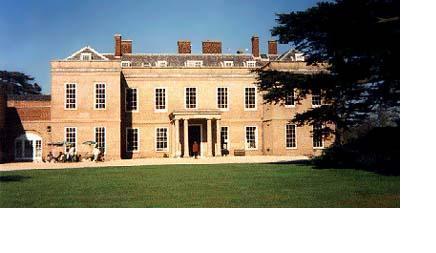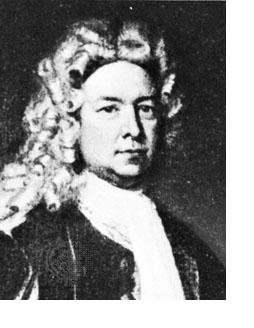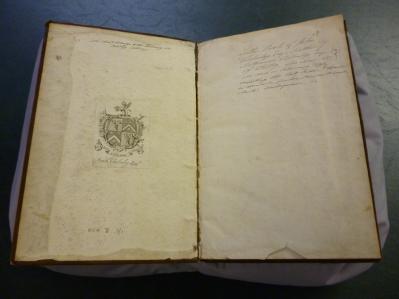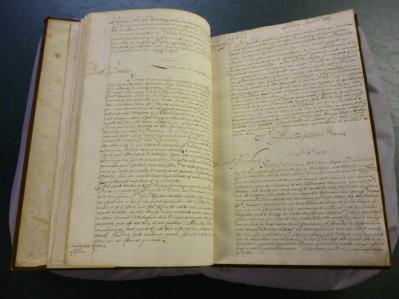Background

Swallowfield Park began life as a Tudor mansion, but in 1689-91 Henry Hyde, second Earl of Clarendon employed architect William Talman to transform it. In the eighteenth century Thomas ‘Diamond’ Pitt purchased the house and Swallowfield began its long relationship with the East India Company. Over a century later the Russell family bought the estate, renovating and reimagining it anew.
The image on the left shows present-day Swallowfield, a building that bears the marks of its different owners. The original Talman house comprised a H-shaped layout with short projections to the front (as seen in the image left) and more extended ones to the rear. Henry Russell greatly altered the internal layout of the house in the 1820s, by creating a main corridor and fashioning a dining room out of the old offices. The dining room was serviced by a kitchen in the north wing (along with the laundry), while the kitchen was serviced by a slaughterhouse and brewery on the south side. Henry Russell also changed the exterior appearance of the house by plastering over the brick facade (seen on the building to the extreme left) and adding a small portico. In doing so he created the neo-classical house that remains recognisable even today.
Swallowfield Park was built in 1689-91 by Henry Hyde, the second earl of Clarendon (1638-1709) to replace the Tudor mansion of the alchemist and antiquary William Backhouse (1593-1662). Clarendon had taken as his second wife William Backhouse’s daughter, the heiress Flower Backhouse (1641-1700). Owing debts of over £19,000, the second earl sold lands (eventually including the Hyde family seat of Cornbury) to stave off his creditors, and retreated to his wife’s estate at Swallowfield in an attempt to reduce his expenditure. Through its connection with Clarendon, seventeenth-century Swallowfield was associated with both the court party and the Stuart cause. As an infant, Henry Hyde had been taken into exile on the continent by his parents after the royalist defeat in the Civil War. His subsequent political career, with only a few short-lived departures, was staunchly royalist. Having declined to accept the new regime imposed by the Glorious Revolution of 1689, Clarendon was imprisoned in the Tower by William III in 1690 and 1691. Denied a place in parliamentary politics by his continued allegiance to the Stuart cause, Clarendon turned to the consolations of domestic architecture. In replacing the existing Tudor mansion at Swallowfield with a new country house, he chose for his architect William Talman (c. 1650-1719). Talman, who as comptroller of the king’s works undertook Hampton Court Palace’s interior decoration, was one of the most influential country house architects of the late seventeenth century and produced a number of innovative designs.
Talman was also the architect of Holywell House, St Albans (which he built for John and Sarah Churchill in c. 1686), of Richard Lumley’s Stansted Park, Sussex (built from 1686 to 1690) and of Uppark, also in Sussex (built for Ford Grey in c. 1690). A small vestibule at Swallowfield is now the only surviving Talman interior. Other country houses that bear the impress of Talman’s hand include Burghley House, Northamptonshire and Chatsworth House, Derbyshire.
Through its association with the Hyde family, Swallowfield was connected to England’s tumultuous seventeenth-century transition from Stuart absolutism to constitutional monarchy. The eighteenth century, in contrast, saw the beginning of Swallowfield’s long association with the history of Britain’s emerging empire in India. For in 1719 this Berkshire country seat passed from Tory into emphatically Whig hands with its purchase by the politician and East India merchant Thomas Pitt (1653-1726).
Thomas 'Diamond' Pitt
 Born in Dorset, Pitt gained notoriety for his opposition to the East India Company’s monopoly of trade on the Indian subcontinent. He first set sail for India in 1673, and rapidly established himself as a successful interloper in the Company’s developing circuits of Asian commerce—much to the chagrin of the Court of Directors. Having returned to England in the 1680s, Pitt was elected MP for Old Sarum, and lambasted the Company’s monopoly over Indian trade from the safety of his seat in the House of Commons. He journeyed back to India as an interloping merchant in 1693, forcing the East India Company’s directors to reconcile themselves to his commercial presence on the subcontinent. Although Pitt remained estranged from influential senior figures in the Company such as Sir Josiah Child (c. 1631-1699) (who had a family residence at Wanstead House, Essex) , he secured appointment by the Company in the later 1690s as Governor of Fort St George at Madras (present-day Chennai).
Born in Dorset, Pitt gained notoriety for his opposition to the East India Company’s monopoly of trade on the Indian subcontinent. He first set sail for India in 1673, and rapidly established himself as a successful interloper in the Company’s developing circuits of Asian commerce—much to the chagrin of the Court of Directors. Having returned to England in the 1680s, Pitt was elected MP for Old Sarum, and lambasted the Company’s monopoly over Indian trade from the safety of his seat in the House of Commons. He journeyed back to India as an interloping merchant in 1693, forcing the East India Company’s directors to reconcile themselves to his commercial presence on the subcontinent. Although Pitt remained estranged from influential senior figures in the Company such as Sir Josiah Child (c. 1631-1699) (who had a family residence at Wanstead House, Essex) , he secured appointment by the Company in the later 1690s as Governor of Fort St George at Madras (present-day Chennai).
From his base in Madras, Pitt accumulated a vast fortune, a process of enrichment perhaps best exemplified by his purchase from an Indian merchant in 1702 of a 410 carat diamond. Acquired by Pitt for £20,400 and shipped to England to be cut and sold for profit, this gem initially proved a vexing investment. Warfare had disrupted the European diamond market, and Pitt (who sailed from India for Europe in 1709) succeeded in selling his Indian jewel only in 1717. The Pitt diamond, purchased for £125,000 by the Regent of France, came to adorn the French crown, was worn by Marie Antoinette and later decorated Napoleon I’s sword.
Diamonds were central to the East India Company’s trade in this period. The letter books of John and Nathaniel Cholmley, which are held at the North Yorkshire County Record Office and appear below, provide detailed evidence of the vitality of this trade.
and appear below, provide detailed evidence of the vitality of this trade.


The letter books of John and Nathaniel Cholmley are held at the North Yorkshire County Record Office which is working in partnership with The East India Company at Home, 1757-1857 project. The North Yorkshire County Record Office is headed by Keith Sweetmore a member of The East India Company at Home, 1757-1857 Advisory Board.
which is working in partnership with The East India Company at Home, 1757-1857 project. The North Yorkshire County Record Office is headed by Keith Sweetmore a member of The East India Company at Home, 1757-1857 Advisory Board.
In the meantime, profits from his lucrative Indian commercial dealings and the sale of his diamond had allowed Pitt, the son of a Dorset rector, to purchase extensive estates that stretched from Cornwall to Westminster. Shortly after the sale of his Indian gemstone, Thomas ‘Diamond’ Pitt established himself as a Berkshire country gentleman at Swallowfield. He died there in 1726, leaving this new country seat to his son Robert (c. 1680-1727), who like his father had traded as a free merchant in Madras before settling in the Berkshire countryside. Intrepid trader and Whig politician, Pitt in India had laid the foundations of a political dynasty that was to include two distinguished Georgian prime ministers: his grandson William Pitt, first earl Chatham (1708-1778) and his great-grandson William Pitt the Younger (1759-1806).
Changing Hands
In the Georgian era, Swallowfield changed hands several times, and its link to Britain’s expanding Indian empire was temporarily broken. The Pitt family sold the estate in 1737, reportedly for £20,770. Swallowfield was sold again in 1783 when Sylvanus Bevan purchased it from Colonel John Dodd. Bevan in turn sold the estate in 1788, to Timothy Hare Earle. His son, Timothy Hare Altabon Earle, inherited Swallowfield in 1816. The younger Earle, whose wealth rested on the Caribbean rather than the Indian empire, suffered increasingly from the early nineteenth-century depreciation of West Indian property. Swallowfield’s lands were enclosed in 1817, an agrarian strategy calculated to drive up its landlord’s profits. [For more information about enclosures in Berkshire, visit the Berkshire Record Office website and investigate their 'New Landscapes' project.]
But by 1820 Earle’s declining fortune and his extravagant lifestyle forced him to sell the estate to the Russells. Earle retired to ‘The Elms’, a dower-house near Wokingham, where he died in 1836.
To learn more about the Russells, go to the next section The Russells of Swallowfield Park.
Swallowfield Park Timeline
This time line tracks the various owners of Swallowfield Park from the seventeenth century to the present day.
1689-91 Swallowfield Park newly designed by William Talman (c.1650-1719) and rebuilt by Henry Hyde, second earl of Clarendon (1638-1709), replacing the Tudor mansion of the alchemist and antiquary William Backhouse (1593-1662).
1719 Politician and Indian merchant Thomas Pitt (1653-1726) purchases Swallowfield Park.
1726 Thomas Pitt dies and Swallowfield passes to his son Robert Pitt (c.1680-1727).
1737 Pitt family sells the estate.
1783 Colonel John Dodd sells Swallowfield to Sylvanus Bevan.
1788 Sylvanus Bevan sells the estate to Timothy Hare Earle.
1816 Timothy Hare Earle’s son Timothy Hare Altabon Earle inherits the estate.
1817 Swallowfield Park’s lands enclosed.
1820s The Russell’s purchase Swallowfield Park.
Do you have any information on the exact date of purchase? If so, please get in touch via the comments page below.
1826 The Russell’s begin to renovate Swallowfield Park.
1852 Sir Charles Russell, third baronet, (son of Sir Henry Russell, second baronet) becomes owner of Swallowfield Park.
1883 Sir George Russell, fourth baronet, (third son of Sir Henry Russell, second baronet) becomes owner of Swallowfield Park.
1898 Sir George Russell, fifth baronet, (son of Sir George Russell) becomes owner of Swallowfield Park.
1965 Swallowfield Park turned into private flats.
